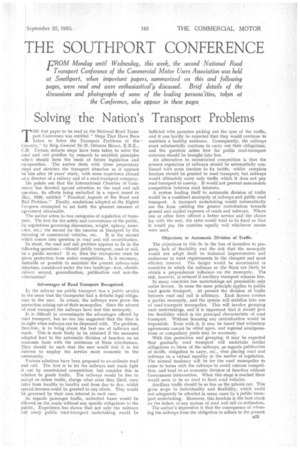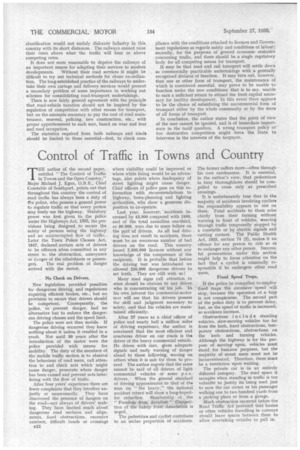Solving the Nation's Transport Problems
Page 31

Page 32

If you've noticed an error in this article please click here to report it so we can fix it.
T HE first paper to be read at the National Road Transport Conference was entitled " Steps That Have Been Taken to Solve the Transport Problems of the Country," by Brig.-General Sir H. Osborne Mance, K.B.E., C.B. Certain definite steps have been taken to solve the roal d and rail probtem 'by research to establish principles wbich should form the basis of future legislation and cci-operation. The author deals with these preparatory steps _and sketches the transport situation as it appears t6 him after 10 years' study, with some experience abroad aS a director of a railway and of a road-transport company.
He points out that the International Chamber of Commerce has devoted special attention to the road and rail question, its efforts being embodied in a report issued in May, 1935, entitled " Practical Aspects of the Road and Rail Problem." Finally, resolutions adopted at the Eighth Congress attempted to set forth the greatest measure of agreement obtainable.
The author refers to two categories of regulation of transport. The first for the safety and convenience of the public, by regulations governing dimensions, -weight, upkeep, insurance, etc.; the second for the exercise of transport by the
licensing of commercial vehicles, etc. It is the second which comes into question in road and rail co-ordination.
In short, the road and rail problem appears to lie in the following questions :—Should public transport, road or rail, be a public service? If so, then the transporter must be given protection from unfair competition. . Is it necessary, desirable or possible to maintain the present railway-rati structure, considered under the two headings—first, classification; second, generalization, publication and non-discrimination?
Advantages of Road 'Transport Recognized.
In the railway era public transport was a public service in the sense that the transporter had a definite legal obligation to the user. In return, the railways were given the protection arising out of their monopolies. Since the advent of road transport the railways have lost this monopoly.
It is difficult to overestimate the advantages offered by road transport, hut no one has suggested that the time is in sight when railways can be dispensed with. The problem, therefore, is to hring about the best use of railways and roads. This is most likely to be attained if the measures adopted lead to the automatic division of function on an economic basis with the minimum of State interference. They should be such that the user would find it in his interest to employ the service most economic to the community.
Various solutions have been proposed to co-ordinate road and rail. The first is to let the railways and roads fight it out by unrestricted competition; but consider this in relation to goods traffic. The railways would be free to accept or refuse traffic, charge what rates they liked, vary rates from locality to locality and from day to day, whilst special favours could be granted to any client. They would be governed by their own interest in each case.
As regards passenger traffic, unlimited buses would be allowed on the roads without any specific obligations to the public.. Experience has shown that not only the railways but every public road-transport undertaking would be inflicted with parasites picking out the eyes of the traffic, and it can hardly be expected that they would continue to maintain a healthy existence. Consequently, the railways must substantially continue to carry out their obligations, and the question arises how far public road-transport concerns should be brought into line.
An alternative to unrestricted competition is that the present regulation of railways should be substantially continued with more freedom to fix tariffs, whilst complete freedom should be granted to road transport; but railways would ultimately carry only traffic which it does not pay road transport to convey. It would not prevent uneconomic competition between road interests.
A system lending itself to automatic division of traffic would be a combined monopoly of railways and public road transport. A transport undertaking would automatically use the form yielding the greater contribution towards general and capital expenses of roads and railways. Where one or other form offered a better service and the choice lay with the user,the rates would tend to he fixed so that it would pay the combine equally well whichever means were used.
Objections to Automatic Division of Traffic.
The objections to this lie in tho loss of incentive to progress, lack of flexibility and the risk that the monopoly would not adapt itself to technical improvements and endeavour to meet requirements in the cheapest and most efficient manner. The danger would be accentuated in countries in which the railways or the State are likely to obtain a preponderant influence -on the monopoly._ The risk, however, is reduced if ancillary transport remains free.
In many countries bus undertakings are permissible only under licence. In some the same principle applies to public road goods transport. • At present the division of traffic between road and rail is arbitrary. Each licence confers d partial monopoly, and the system will stabilize into one of road-transport monopolies. This will involve grouping such undertakings, and it is important that it should give the flexibility which is the principal characteristic of road transport. Without licensing any centralisation would be impossible. Even with it, it may be found that voluntary agreements cannot be relied upon, and regional amalgamations or compulsory pools may he necessary.
With this protection and grouping, it may be expected that gradually road transport will undertake similar obligations to those of the railways, as regards publication of tariffs, obligation to carry, etc., thus placing road and railways on a virtual equality in the matter of regulation. The natural tendency will be for the road monopolies to conic to terms with the railways to avoid ruinous competition, and tend to an economic division of function without Government intervention, When this stage is reached there would seem to be no need to limit road vehicles.
Ancillary traffic should be as free as the private car. This gives scope to individuality and flexibility, which could not adequately be afforded in many cases by a public transport undertaking. Moreover, this freedom is the best check on the failure of any system of road and rail co-ordination.
The author's impression is that the consequence of releas ing the railways from the obligation to adhere to the present classification would not unduly dislocate industry in this country with its short distances. The railways cannot raise their rates above what the traffic will bear or above competing rates.
It does not seem reasonable to deprive the railways of an important means for adapting their services to modern developments. Without their road services it might be difficult to try out technical methods for closer co-ordination. The long-established practice of the railways to undertake their own cartage and delivery services would present a secondary problem of some importance in working out schemes for consolidating road-transport undertakings.
There is now fairly general agreement with the principle that road-vehicle taxation should not be inspired by the regulation of competition with other means for transport, but on the amounts necessary to pay the cost of road maintenance, renewal, policing, new construction, etc., with proper apportionment to each user, based on wear and tear and road occupation.
The statistics required from both railways and roads should be limited to those essential—first, to check com
pliance with the conditions attached to licences and Government regulations as regards safety and conditions of labour; secondly, for the purposes of general economic statistics concerning traffic, and there should be a single regulatory body for all competing means for transport.
It may be that road and rail transport will settle down as commercially practicable undertakings with a generally recognized division of function, It may turn out, however, that one or other form of transport, the maintenance of which is considered essential, may prove to be unable to function under the new conditions: that is to say, unable to earn a sufficient return to attract the fresh capital necessary for healthy development. In this event there appears to be the choice of subsidizing the uncommercial form of transport either by the whole community or by the users of all forms of transport.
In conclusion, the author states that the point of view of the user cannot be ignored, and is of immediate importance in the tariff question. A wrong transport policy or too destructive competition might force the State to intervene in the interests of the taxpayer.




















































































